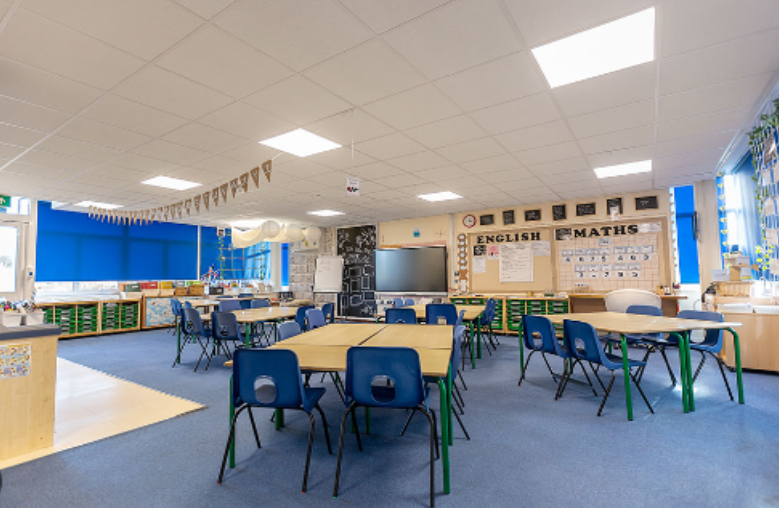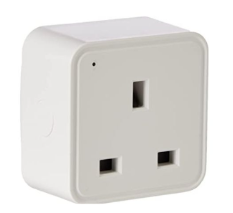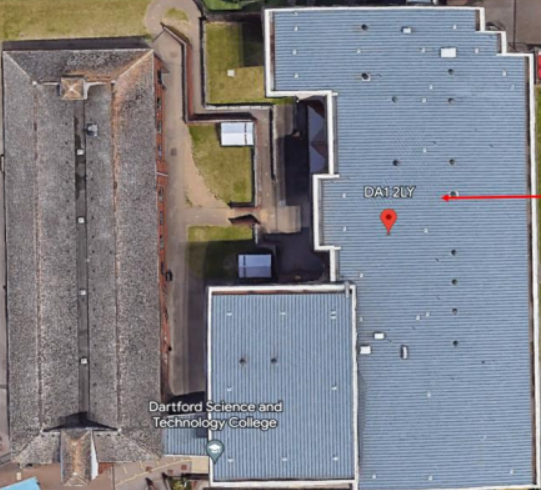Our School Site
Our premises and school grounds are always developing to be more sustainable. This section of the website details what we have done so far and our next steps towards greater sustainability.
Energy Efficiency Projects - Completed
LED Lighting
It had been estimated that replacing all remaining fluorescent lamps with LED lighting across the site will reduce the associated lighting energy consumption by 37,492 kWh p.a. or approximately 47% with an initial annual saving of £11,248 on a capital investment of £81,890.
Therefore the school began an extensive LED lighting replacement programme across the entire school estate in 2021.

This is an ongoing project aimed at reducing electrical utility costs and is funded mainly from the school maintenance budget, but we have also applied to outside agencies for funding to help us reach the target of converting all existing fluorescent lighting to LED within 5 years.

Smart Plug Implementation
The school is currently installing energy saving smart plugs to high use appliances across the site, starting with water heaters and water fountains previously powered “On” 24/7.
This gives the school the ability to remotely programme any electrical device connected to the system to switch “On/Off” at predetermined times of high usage and allows the school to benefit from the savings made in reduced electrical utility costs.

Energy Efficiency Projects - Future Planning
Upgrade BMS (Building Management System) Heating Controls
A Building Automation System (BAS) is a computer-based system installed to control and monitor a building's electrical equipment, such as ventilation, lighting, heating, fire, security systems and consists of software and hardware components. This upgrade will result in significant energy savings for the school currently estimated to be at least 10% with an initial annual saving of £2,684 on an estimated capital investment of £15,400.
Improve Building Fabric to Reduce Heat Loss
Our aspiration is to use electrically driven heat pumps, install thermal fabric improvements and continue with our lighting upgrades. These measures provide several benefits, which include the following:
- Reducing heat losses from the building thus reducing energy use and therefore running costs.
- Installing energy efficient lighting systems to reduce electricity consumption and cost
Considering switching to heat pumps means we can:
- Reduce the need to replace heating emitters
- Reduce the size of the heat pump required to meet the heating demand
- Reduce the capital costs by being able to select a smaller heat pump
Install Loft Thermal Insulation
The school includes traditional tiled pitched roof structures e.g. in the 'A Block.'
During the Heating Decarbonisation survey carried out by 'Zenergi' it was noted that A Block and The Hub loft spaces may contain minimal quantities of thermal insulation (i.e., around 100mm insulation depth).
It was recommended that thermal insulation be installed within the loft spaces, as recommended within the current Building Regulations Part L2B.
The installation of loft insulation will improve the thermal comfort conditions within the buildings and reduce energy usage. The total area of pitched roof to be insulated is estimated to be 806 m2 . The savings are based upon an assumed U-Value (thermal transmittance) of the existing roofs being 0.42 W/M2K and the U-Value of the proposed upgraded insulated roofs is 0.14 W/M2K (Ref: CIBSE Design Guide A, table 3.50). The resulting annual fuel savings are 5,536 kWh p.a (2%) with an initial annual saving of £376 on a capital investment of £13,299.
Install Cavity Wall Thermal Insulation
The schools older buildings (i.e., A Block and The Hub) external brick walls may contain an uninsulated cavity space (TBC). If confirmed, it is recommended that cavity wall thermal insulation be installed to reduce the heat loss from the buildings.
It has been estimated that the total wall area to consider for cavity insulation is approximately 1,035 m2 . Which if insulated could provide an annual saving of 8% of the total heating bill which is an initial annual saving of £1,899 on a capital investment of £29,886.
Install a 150 kWp solar PV array to Block B
Solar Photovoltaics (PV) is an active solar technology which produces electricity from solar radiation using solar cells encapsulated in panels called PV modules.
Installing a solar PV system to generate electricity would reduce the grid consumption, energy costs and carbon emissions.
Additionally, renewable energy technologies can provide resilience to economic changes in the form of fluctuating energy prices, and improved energy supply security using decentralised generation.
It has been recommended that solar PV panels be installed onto B Block flat roof apex.

Decarbonisation
The School has been working hard to meet the net zero target set by the government which expects all schools to reduce their greenhouse gas emissions to 'zero' by 2050.
The school has designed a Heating Decarbonisation plan which details our current emissions and sets out a road map of how we plan to reduce these going forward. The school is also working with partners such as 'Let’s Go Zero', 'Salix' and 'Reenergise', who are able to support the school on its journey to net zero.
The school also recently applied for funding via the government's own Local Carbon Skills fund. Our application was successful contributing a staggering £75,096.02 to the net Zero fund which will be allocated to completing building condition audits and assessments. Feasibility studies and a full redesign of the schools heating, lighting and electrical systems will help to transition the site from mainly fossil fuel to a full net zero plant and equipment.
This Project will take many years to complete and there are huge challenges, but it is hoped that by working together we can play our part in reducing worldwide gas emissions to near zero, making the world a safer environment for future generations.

